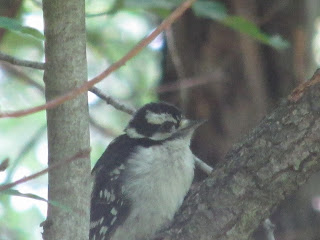 |
| Young Downy Woodpecker has just left the nest. by Grandma Pearl |
Mama Downy Woodpecker has been showing her fledglings where the bird feeders are. I have enjoyed watching them interact as the babies beg for food. Mama dutifully pulls a seed out of the feeder and flies to the branch where her little one waits. She sometimes lands on the branch several feet from her youngster, presumably to coax it to come to her rather than the other way around.
 |
| Baby Downy Woodpecker on the left, waits for its parent (on the right) to feed it. By Grandma Pearl |
Both a male and a female baby Downy woodpecker have made short, insecure flights around and near the feeders. They seem to prefer a small tree behind the feeders at the edge of the woods. (Although I have seen them clinging to the edge of one of the feeders.) There they can watch how their Mom flies to and lands on the feeder, picks out just the right sunflower seed, and flies to a tree to open up the shell.
Baby Downys use a high-pitched ‘begging’ call to let their mother know they want to be fed. This will go on for about a week or so, then she will decide that despite their pleas she must let them start fending for themselves. Watching nearby, she will make sure there are no predators in the area.
 |
| Female Baby Downy Woodpecker practices her landings! by Grandma Pearl |
As the days go by, the young Downy Woodpeckers will become as proficient at flying from tree to tree as their parents. It just takes practice; and it helps that the parents keep watch over them as they develop into self-sufficient juveniles, and then progress to adulthood.
The whole family will remain here year round ridding my trees and shrubs of destructive insects. I show my appreciation by feeding them through every season; and offering suet and mealworms when colder weather settles in. I’m glad to see the newest generation learning how to survive and thrive!
Grandma Pearl
 |
| Cute little Female Baby Downy Woodpecker, by Grandma Pearl |



















